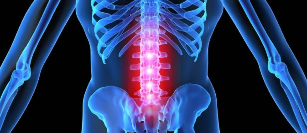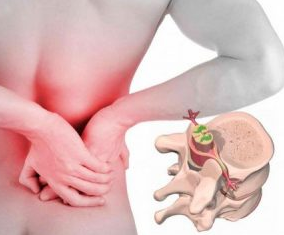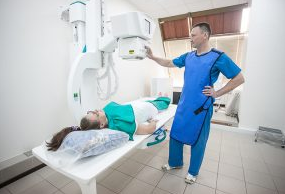Degenerative disease in which the body, the deformation of the spine and of the intervertebral disc, destroyed called osteochondrosis of the lumbar spine. Causes for such interference can be varied, and in order to be properly treated, it is important to note that it may influence on the progression of deformation in the lower back. If the people disease worried about the characteristic symptoms of the degenerative disc, you should treat immediately to the hospital.
On level 1 in the location of the Problem to cure drugs and special exercises, but 2-3 degrees is the conservative method is not always helps, therefore, it is necessary to have recourse to surgical methods of treatment.

The main reasons
Left-sided or right-sided lumbar osteochondrosis — disease of degenerative nature, in which the disc is destroyed, the fiber ring and torn and in its place is a hernia occurs, causing the sharp pain and dysfunction of the musculoskeletal system. Provoke back pain in the lower back may be due to the following factors:
- increased physical strain on the lower spine;
- incorrect Position of the body when walking, sitting;
- sedentary, sedentary lifestyle;
- impaired posture;
- Injuries, fractures, or injuries, caused degenerative consequences in the spine;
- congenital pathology of the construction of the supporting and locomotor system, in which signs of deformation and you notice that already in a child;
- Obesity;
- Stress, improper diet.
Stages and symptoms.
To develop symptoms of lumbar degenerative disc disease, if the disease progresses, and the bigger the stage, the more the Symptom manifests itself. There are a total of 4 stages:
- Level 1-fibre ring a negligible damaged, the pain bothers not expressed and often after a long walk. Pressure sensitivity is expressed by 2 types of low back pain, if a Symptom interferes constantly, and lumbago, in which the symptoms occur suddenly.
- Osteochondrosis POP 2 degrees is characterized by a great destruction and Degeneration of the Anulus fibrosus and the disc. Such a violation leads to a reduction in the space between the vertebrae and a feeling of pressure nerve fibers. Progressive 2 stage is not accompanied by severe pain in the lower back, to feel in the morning stiffness that is difficult to forget.
- On 3 levels fiber ring in the affected area is completely destroyed, which is why hernia is formed, the roots of the blood vessels and nerves. The back doesn't hurt constantly, if the symptoms after rest and lowering of loads, senses tingling, and heaviness in the legs. In the third stage, the Degeneration of the muscle fibers takes place, whereby the limited movement of the patient.
- In 4. Stage, the spine is deformed is full, people are worried about acute pain, because of the motor skills are completely limited. Because of the violation of the Innervation and the blood supply swelling of the legs, between the vertebrae, the bone formation to grow. The last degree is high, the risk of disability.
Syndromes of osteochondrosis of the lumbar spine
Lumbar osteochondrosis is manifested in the following syndromes:
- Armbar. This is the main Symptom of the degenerative-dystrophic disorders of the spine. With progression of the pathology symptoms of progression can be expressed, the seizures can last up to a few days, have a negative impact on human health.
- Radicular. Because of the thinning of the damaged body, the Disc height of the Band room, the vortex will be reduced, resulting in unstable, irritating and compressing the nerve endings. People are worried about acute pain, inflammation of the nerves, circulatory disorders. Muscular-skeletal atrophy and, therefore, the functionality of the lower extremities is disturbed.
- Ischemic. Progressive osteochondrosis of the lumbar spine leads to the blood vessels and arteries, which over the spine begin to compress. This interferes with the circulation of the blood and thus the nutrition of the internal organs and tissues, but also the cause of acute pain in the inner side of the thigh, in the area of the dam. If the Problem is not timely to fix, possible paralysis, or paresis.
- Vertebral. With the progression of pain, ischemic, and the arrangement of the edge of the syndromes of the spine, the patient's progress is deformed gradually, which is a significant impact on the condition and well-being. The muscles are weak, the gait, the man tried, the distribution of the load on the spine, so that experience of the movement a minimum of discomfort. Such violations impact on the work of the internal organs, the intervertebral discs deform still more, and damaged.

If the treatment of degenerative disc disease of the lumbar spine was inadequate or not performed in a timely manner, can develop dangerous complications. In women with lesions of the spine at the level of L1—S1, it can have complications during pregnancy, particularly in the last stages, when the load on the spine max. In men, degenerative processes in the lumbar spine are often the cause of problems with potency. Early treatment reactive spondylosis, as well as the high likelihood of developing osteoarthritis of the knee, the hip joint. Manifest and other effects:
- Compression-vascular ischemia;
- Tab;
- spondylarthrosis;
- Paresis.
Diagnosis
A doctor was able to pick up effective treatments, it is necessary for an accurate diagnosis. The diagnosis begins in the office of the nervous doctor, the scans, a first inspection of the affected area, to estimate the character of changes in the spine. In the acute Phase, the Patient can hardly move and run, no complicated manipulations. For a detailed examination of the spine instrumental diagnosis assigned, which includes:
- X-ray images. In the 3 projections, the images, the extent of Progression of the pathology, the size of the Band slot, salt deposits show the structure of the vertebral body.
- CT or MRI. Provide a detailed picture of the condition of the spine and disk injuries in the soft parts, what I can't examine x-ray examination show.
How to treat the Problem?
Drugs
The disease is the pain a Symptom of progress, not to be done with the all the drugs may. In the initial phase, to relieve symptoms the dose can tablets of pain. And the Problem is treated with special ointments and gels. In advanced cases, such drugs will prove to be ineffective, the doctor may prescribe injections, the pain relief and the first time according to be.

Non-steroidal anti-inflammatory drugs relieve swelling and inflammation, decrease resulting in the nerve fibers and blood vessels compress, and pain symptoms. To the group, the means include:
- For the pain. With the progression of the acute Phase if pain is severe, prescribers of this group proceed. Since you have side effects, do not buy the funds at its sole discretion. A safe and effective medicine must appoint a physician.
- Muscle relaxants. Relieve muscle spasms, reduces pain and discomfort.
- Glucocorticoids. Eliminate the inflammation, have a positive effect on the nervous system, improves the condition of the patient in a short period of time.
Exercises
If diagnosed osteochondrosis of the L5—S1 or amazement drives at the level of L3—S1, mandatory medical gymnastics is assigned. In the implementation of the training of the complex, it is important to increase the load gradually in order not to discomfort and pain arise. Recommended for osteochondrosis of the following exercises:
- To do In a standing Position, turns to the right-to the left, tilts to the front-to-rear.
- Standing on all fours, bending over and leveling the back.
- Lying on the floor, lift smooth legs without the lower back from the floor.
- In the supine position with the left Hand, attracted to limbs on the right and Vice versa.
Massage and physiotherapy
Chronic osteochondrosis in a stage of Remission treated successfully carried out with the help of massage, manual therapist. Massage can help to normalize the blood circulation in the affected area, establish food. Similar is the effect of physiotherapeutic procedures:
- Electrophoresis;
- Magneto-Therapy;
- Laser therapy;
- UHF.
If patients are not helped with left-sided or right-sided osteochondrosis conservative methods, means, that without a surgical treatment can not do. Often microdiscectomy is, in the case of the anti-virus sequestered hernia with the aid of micro-surgical instruments. Procedure minime psidium, the next day after the Operation, the Patient can begin to move.
Prevention
As osteochondrosis adults and children suffering, it is important, also with small children the spine to monitor, control your posture, attention, how the curve when sitting, or movement looks. If it is to go to suspected deformation, should a doctor. The earlier a disease is diagnosed, the easier it is to deal with him then.


















